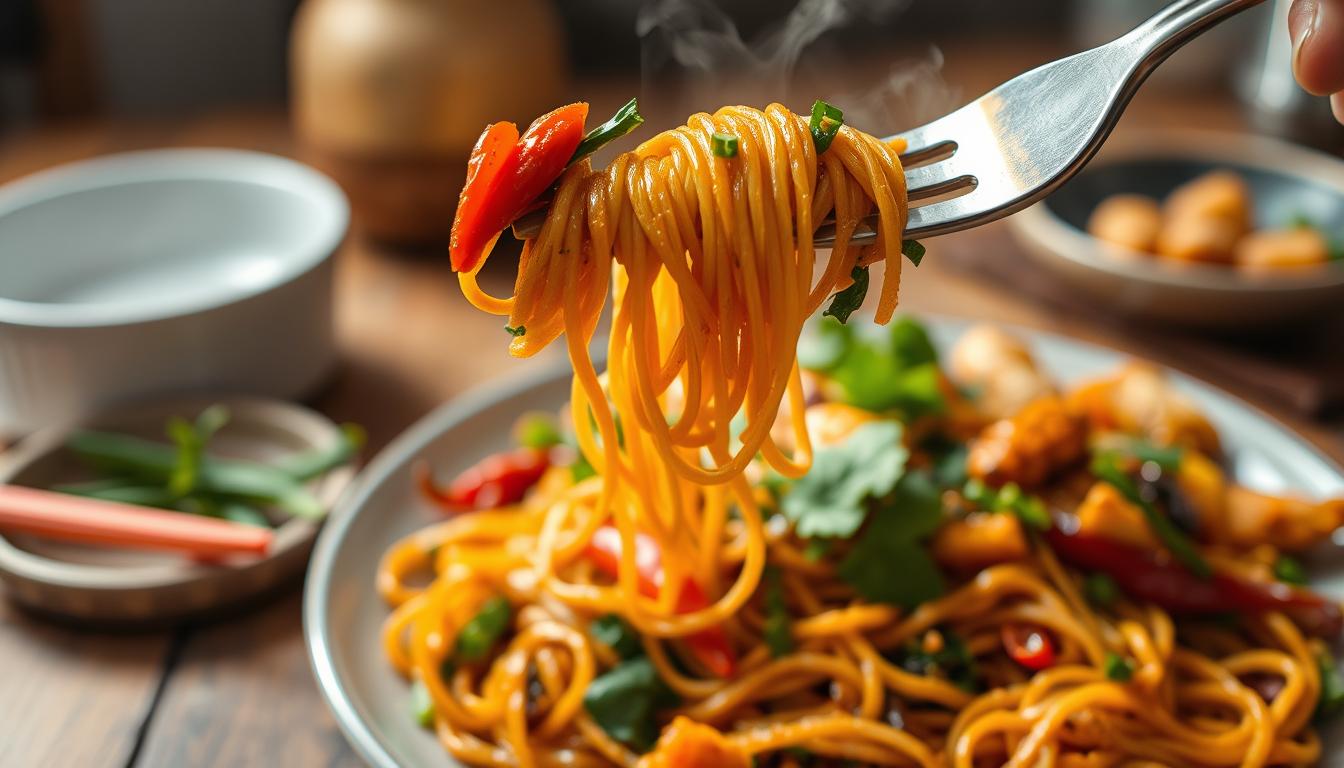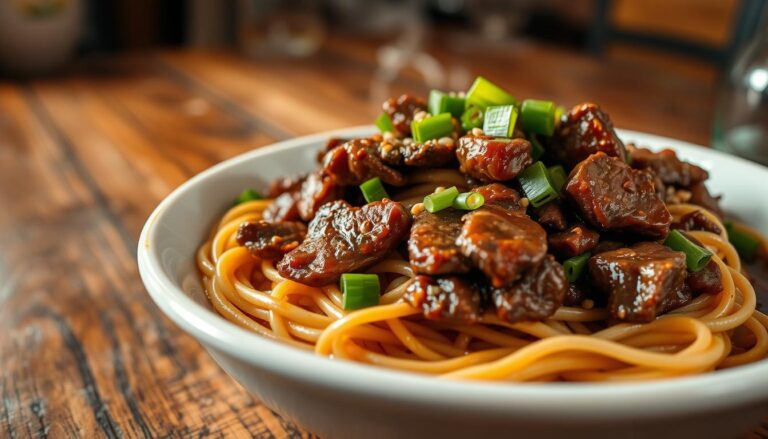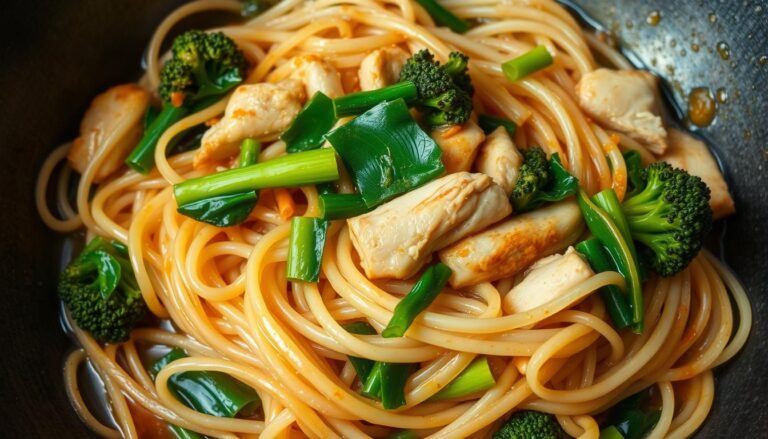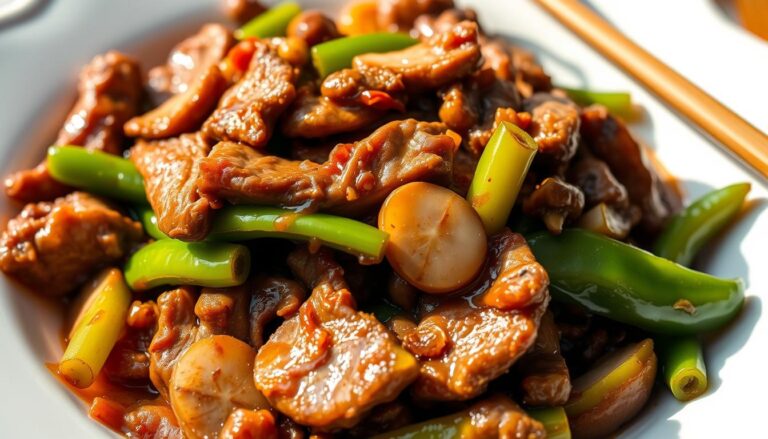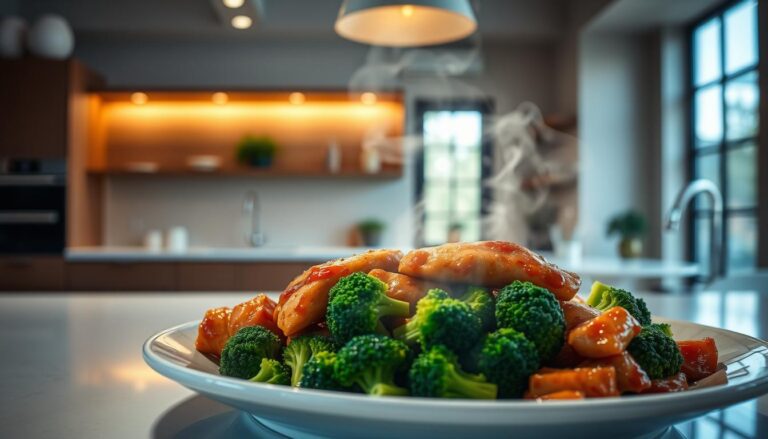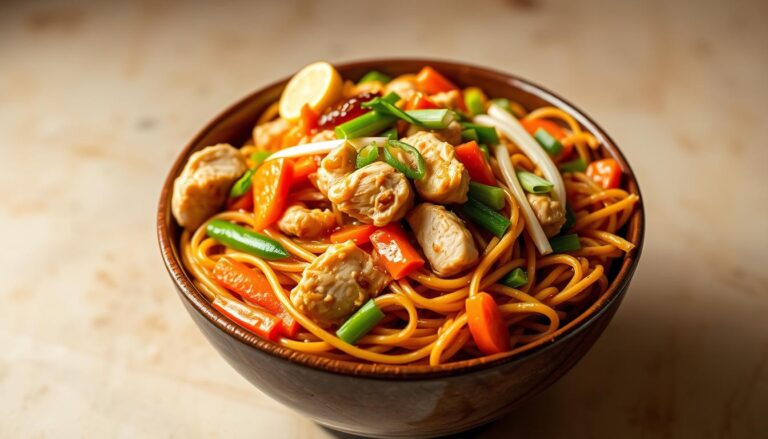Easy Drunken Noodles: Spicy Thai Stir-Fry Recipe Guide
Craving bold Thai flavors but short on time? This fiery stir-fry brings the heat of street food to your kitchen in just 30 minutes. Known for its intense spice and savory-sweet balance, this dish gets its playful name from legends of late-night cooks improvising with rice noodles and whatever ingredients they had on hand.
Perfect for busy weeknights, the recipe relies on three essentials: chewy rice noodles, a umami-packed sauce, and aromatic oils. Social media foodies love it for its flexibility—swap proteins or veggies based on what’s in your fridge. Our guide simplifies every step, from soaking noodles to balancing chili heat.
Why does this version stand out? We focus on authentic techniques without complicated steps. The sauce combines fish sauce, soy, and lime for tangy depth, while fresh basil adds a fragrant finish. Whether you’re new to Thai cooking or a seasoned pro, you’ll master this crowd-pleaser quickly.
Key Takeaways
- Ready in 30 minutes, ideal for fast weeknight dinners
- Uses versatile ingredients adaptable to dietary preferences
- Quality rice noodles and fresh herbs ensure authentic texture
- Balanced sauce blends sweet, salty, and spicy flavors
- Inspired by viral social media recipes for modern appeal
Introduction to Thai Cuisine and the Drunken Noodles Tradition
Discover how Thai street food evolved into beloved home-cooked meals. Stir-fry dishes like pad kee mao—literally “drunkard’s stir-fry”—reflect Thailand’s culinary creativity. Legend says chefs crafted these bold-flavored plates after-hours, using fiery peppers and aromatic herbs to revive night owls.
The Cultural Backdrop of Thai Stir-Fry Dishes
Thai cooking thrives on balancing five flavors: spicy, sour, sweet, salty, and bitter. Pad kee mao embodies this harmony. Its name hints at its origin story, but its soul lies in ingredients like Thai basil (horapha) and holy basil. These herbs add licorice-like notes you can’t replicate with regular basil leaves.
Regional variations exist, but the core remains. Southern versions pack more heat with bird’s eye peppers. Northern cooks might use wider rice noodles. Regardless, it’s a dish born from resourcefulness—a trait central to Thai food culture.
Why This Recipe is Perfect for Your Weeknight Meals
You’ll love how pad kee mao fits modern life. Pre-soaked rice noodles cook in minutes. The sauce? A quick mix of soy, fish sauce, and lime. Swap proteins or veggies based on what’s fresh. Even the basil can flex—use Thai basil for authenticity or sweet basil in a pinch.
It’s faster than takeout but richer in flavor. The wok hei (breath of the wok) technique locks in smoky depth. Best part? You control the chili flakes. Make it mild for kids or fiery for spice lovers. Tradition meets Tuesday-night practicality.
Key Ingredients and Flavor Foundations
The magic of this dish starts with three pillars: chewy noodles, aromatic herbs, and a sauce that punches above its weight. Get these elements right, and you’ll unlock layers of flavor rivaling your favorite Thai takeout spot.
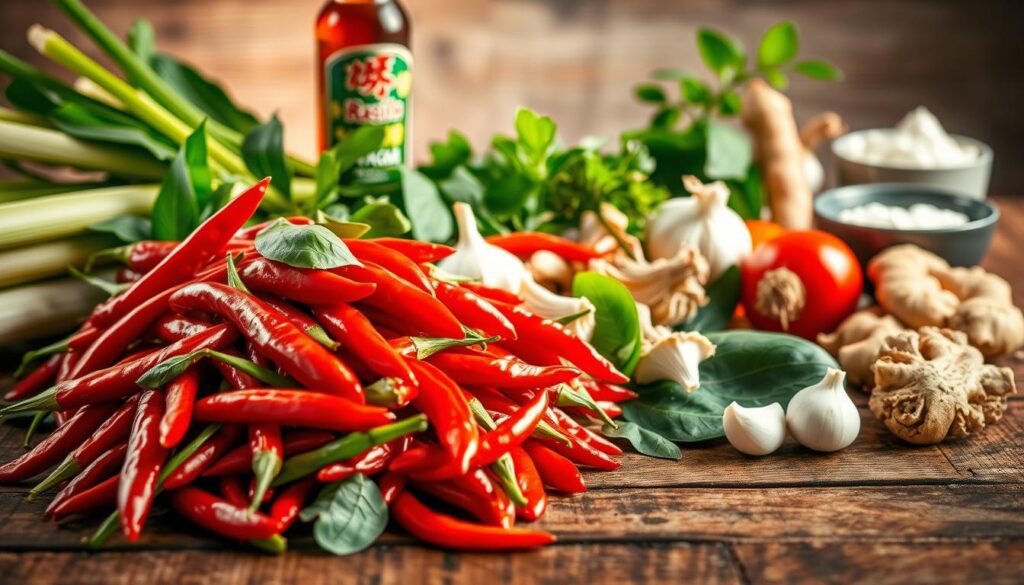
Rice Noodles, Basil, and Sauce Essentials
Wide rice noodles are non-negotiable. Their flat surface grabs sauce better than spaghetti-shaped varieties. Soak them in cold water for 10 minutes—this prevents mushiness during stir-frying. Fresh Thai basil (not the Italian kind) adds peppery notes that cut through richness.
Your sauce needs four allies in a small bowl: soy sauce for saltiness, fish sauce for funk, oyster sauce for sweetness, and sugar to balance the heat. Use a ¼ cup measure for precision—too much fish sauce overwhelms, too little leaves the dish flat.
Understanding the Role of Soy Sauce, Fish Sauce, and Oyster Sauce
Think of these sauces as your flavor triad. Soy sauce forms the base with its umami depth. Fish sauce—just 1-2 tablespoons—brings savory complexity. Oyster sauce thickens the mix while adding caramel-like sweetness.
Combine them with 2 tablespoons of water to thin the mixture. This lets the sauce coat noodles evenly without pooling at the bottom of your wok. Taste as you go: add sugar if it’s too salty, water if it’s too intense.
Authentic drunken-noodles Cooking Process
Master the art of Thai stir-fry through precise heat control and ingredient sequencing. Your success hinges on three elements: prepped components, a blistering pan, and timing measured in seconds rather than minutes.
Prepping Ingredients for Maximum Flavor
Start by soaking rice noodles in warm water for 8 minutes. They should bend without snapping—al dente texture prevents sogginess. Slice proteins thinly; chicken breast or shrimp cook fastest. Julienne bell peppers and carrots for quick wilting.
Mince 5 garlic cloves—their sharp aroma forms the flavor base. Keep veggies and proteins separate in bowls. This organization lets you add ingredients at the right moment without overcooking.
High-Heat Techniques for Perfect Texture
Heat your wok until oil shimmers. Add garlic and red pepper flakes, stirring 15 seconds until fragrant. Toss in proteins first—they need 2 minutes to sear. Follow with veggies, cooking 90 seconds to retain crunch.
Drain noodles thoroughly before adding to the wok. Pour sauce down the sides, not directly on noodles, to prevent clumping. Use tongs to fold everything together for 1 minute. Remove from heat before tossing in basil—residual heat wilts leaves without burning them.
Serve immediately while steam rises from the bowl. This method locks in smoky wok essence while keeping noodles springy. Adjust chili levels by adding fresh red pepper slices as garnish.
Modern Variations and Adaptations
This fiery stir-fry thrives on personalization. Its flexible nature lets you tailor flavors and textures to match pantry staples or dietary preferences while keeping that signature Thai kick.
Customizing Your Spice Level and Protein Choices
Control heat with precision. Start with ½ teaspoon red pepper flakes, then add more after tasting. For extra smokiness, toast the flakes in oil before adding other ingredients.
Swap proteins effortlessly. Pork tenderloin slices mimic traditional street food versions, while fish sauce-marinated shrimp add coastal flair. Vegetarians can use cubed tofu—press it first to improve texture.
Adapting to Different Ingredients and Dietary Needs
Boost veggie content with baby corn and broccoli. Slice florets thin for quick cooking. Gluten-free? Use tamari instead of standard soy sauce—it’s richer and saltier, so adjust quantities.
Love pad thai ingredients? Incorporate bean sprouts or crushed peanuts. Just ensure your wide rice noodles remain the star—their chewy texture holds up better than thinner varieties when mixed with extra add-ins.
Conclusion
Perfecting this iconic Thai stir-fry comes down to precision and balance. With just a few smart techniques, you’ll create a meal that rivals takeout—minus the wait. The secret? Every teaspoon matters, from tangy oyster sauce to the final drizzle of sesame oil that elevates the entire plate.
Timing is crucial. Remove heat at the right moment to let residual warmth gently wilt fresh basil without losing its aroma. Your rice noodles stay springy, while veggies retain a satisfying crunch. This careful control ensures vibrant flavors linger in every bite.
Don’t underestimate small adjustments. Swapping proteins or tweaking spice levels keeps the recipe fresh for repeat meals. Whether you stick to tradition or experiment, the dish adapts effortlessly to your taste.
Ultimately, drunken noodles prove that great cooking isn’t complicated. It’s about mastering essentials—quality ingredients, bold sauces, and trusting your instincts. Your kitchen just became the best Thai spot in town.
FAQ
Can I substitute rice noodles with another type of noodle?
Yes! While wide rice noodles are traditional, you can use wheat noodles, udon, or even zucchini noodles for a low-carb option. Adjust cooking times based on the noodle type to avoid overcooking.
How do I adjust the spice level if I prefer milder flavors?
Reduce or omit Thai chili peppers and chili flakes. Add diced bell peppers for color without heat. Taste the sauce as you mix it to balance sweetness and saltiness.
Is there a vegetarian version of this recipe?
Absolutely. Swap proteins like pork or shrimp for tofu or extra vegetables like broccoli and baby corn. Use soy sauce instead of fish sauce, and opt for vegan oyster sauce.
Can I make drunken noodles ahead of time?
It’s best served fresh, but you can prep ingredients in advance. Store cooked noodles, chopped veggies, and sauce separately. Stir-fry just before eating to maintain texture.
What’s the difference between drunken noodles and pad Thai?
Drunken noodles (pad kee mao) are spicier, with bold flavors from basil and chili. Pad Thai leans sweeter and tangier, often using tamarind and peanuts. Both use rice noodles but differ in sauce and seasoning.
Can I use frozen vegetables instead of fresh?
Yes, but thaw and drain them first to avoid excess moisture. Fresh veggies like bell peppers and basil leaves provide better texture and flavor in the final dish.

